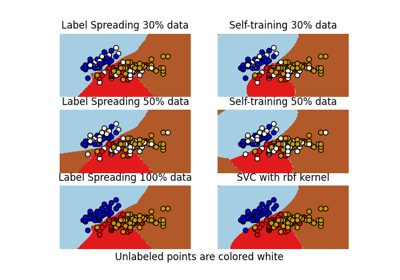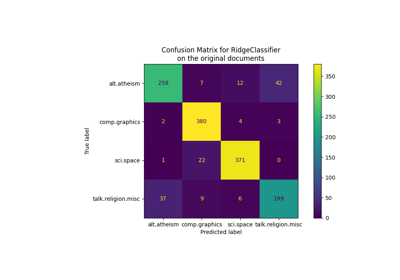备注
Go to the end 下载完整的示例代码。或者通过浏览器中的MysterLite或Binder运行此示例
文本数据集的半监督分类#
在本例中,半监督分类器在20个新闻组数据集(将自动下载)上训练。
您可以通过将类别名称指定给数据集加载器或将类别设置为来调整类别的数量 None 才能拿到全部20个。
2823 documents
5 categories
Supervised SGDClassifier on 100% of the data:
Number of training samples: 2117
Unlabeled samples in training set: 0
Micro-averaged F1 score on test set: 0.885
----------
Supervised SGDClassifier on 20% of the training data:
Number of training samples: 411
Unlabeled samples in training set: 0
Micro-averaged F1 score on test set: 0.773
----------
SelfTrainingClassifier on 20% of the training data (rest is unlabeled):
Number of training samples: 2117
Unlabeled samples in training set: 1706
End of iteration 1, added 1076 new labels.
End of iteration 2, added 222 new labels.
End of iteration 3, added 56 new labels.
End of iteration 4, added 22 new labels.
End of iteration 5, added 10 new labels.
End of iteration 6, added 8 new labels.
End of iteration 7, added 9 new labels.
End of iteration 8, added 6 new labels.
End of iteration 9, added 5 new labels.
End of iteration 10, added 4 new labels.
Micro-averaged F1 score on test set: 0.834
----------
LabelSpreading on 20% of the data (rest is unlabeled):
Number of training samples: 2117
Unlabeled samples in training set: 1706
Micro-averaged F1 score on test set: 0.644
----------
# Authors: The scikit-learn developers
# SPDX-License-Identifier: BSD-3-Clause
import numpy as np
from sklearn.datasets import fetch_20newsgroups
from sklearn.feature_extraction.text import CountVectorizer, TfidfTransformer
from sklearn.linear_model import SGDClassifier
from sklearn.metrics import f1_score
from sklearn.model_selection import train_test_split
from sklearn.pipeline import Pipeline
from sklearn.preprocessing import FunctionTransformer
from sklearn.semi_supervised import LabelSpreading, SelfTrainingClassifier
# Loading dataset containing first five categories
data = fetch_20newsgroups(
subset="train",
categories=[
"alt.atheism",
"comp.graphics",
"comp.os.ms-windows.misc",
"comp.sys.ibm.pc.hardware",
"comp.sys.mac.hardware",
],
)
print("%d documents" % len(data.filenames))
print("%d categories" % len(data.target_names))
print()
# Parameters
sdg_params = dict(alpha=1e-5, penalty="l2", loss="log_loss")
vectorizer_params = dict(ngram_range=(1, 2), min_df=5, max_df=0.8)
# Supervised Pipeline
pipeline = Pipeline(
[
("vect", CountVectorizer(**vectorizer_params)),
("tfidf", TfidfTransformer()),
("clf", SGDClassifier(**sdg_params)),
]
)
# SelfTraining Pipeline
st_pipeline = Pipeline(
[
("vect", CountVectorizer(**vectorizer_params)),
("tfidf", TfidfTransformer()),
("clf", SelfTrainingClassifier(SGDClassifier(**sdg_params), verbose=True)),
]
)
# LabelSpreading Pipeline
ls_pipeline = Pipeline(
[
("vect", CountVectorizer(**vectorizer_params)),
("tfidf", TfidfTransformer()),
# LabelSpreading does not support dense matrices
("toarray", FunctionTransformer(lambda x: x.toarray())),
("clf", LabelSpreading()),
]
)
def eval_and_print_metrics(clf, X_train, y_train, X_test, y_test):
print("Number of training samples:", len(X_train))
print("Unlabeled samples in training set:", sum(1 for x in y_train if x == -1))
clf.fit(X_train, y_train)
y_pred = clf.predict(X_test)
print(
"Micro-averaged F1 score on test set: %0.3f"
% f1_score(y_test, y_pred, average="micro")
)
print("-" * 10)
print()
if __name__ == "__main__":
X, y = data.data, data.target
X_train, X_test, y_train, y_test = train_test_split(X, y)
print("Supervised SGDClassifier on 100% of the data:")
eval_and_print_metrics(pipeline, X_train, y_train, X_test, y_test)
# select a mask of 20% of the train dataset
y_mask = np.random.rand(len(y_train)) < 0.2
# X_20 and y_20 are the subset of the train dataset indicated by the mask
X_20, y_20 = map(
list, zip(*((x, y) for x, y, m in zip(X_train, y_train, y_mask) if m))
)
print("Supervised SGDClassifier on 20% of the training data:")
eval_and_print_metrics(pipeline, X_20, y_20, X_test, y_test)
# set the non-masked subset to be unlabeled
y_train[~y_mask] = -1
print("SelfTrainingClassifier on 20% of the training data (rest is unlabeled):")
eval_and_print_metrics(st_pipeline, X_train, y_train, X_test, y_test)
print("LabelSpreading on 20% of the data (rest is unlabeled):")
eval_and_print_metrics(ls_pipeline, X_train, y_train, X_test, y_test)
Total running time of the script: (0分6.792秒)
相关实例

Decision boundary of semi-supervised classifiers versus SVM on the Iris dataset
Gallery generated by Sphinx-Gallery <https://sphinx-gallery.github.io> _



